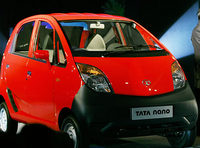Japan's Automakers Take Different Approaches to Low-Cost Cars
Tokyo, Jan 23, 2008; Automakers around the globe are competing intensely to develop low-cost cars for emerging markets, and Japanese manufacturers are no exception.
But despite the allure of rapidly expanding auto demand in nations such as China and India, there are also some Japanese automakers that remain cautious about taking part in the competition, because of the need for drastic cuts in production costs, among other reasons.
The pioneer among such low-cost cars is the Logan, released by France's Renault SA group in 2004. The group succeeded in keeping the Logan's price below one million yen by having it share parts with other Renault cars. The model's accumulated sales reached 460,000 units as of the end of June 2007.
Earlier in January this year, India's Tata Motors Ltd. surprised the world by releasing the no-frills Nano minicar priced at 100,000 rupees, or about 280,000 yen. The 623-c.c. model has no air conditioner, radio or air-bag system.
Leading Japanese automaker Toyota Motor Corp. is currently developing what it calls an "entry family car" with an expected price tag way below one million yen. "The development (of the entry family car) has come to a good level, but there is still room for improvement," says Toyota President Katsuaki Watanabe, suggesting that the model's development is now in the final stage.
Among Toyota's Japanese rivals, Nissan Motor Co. has announced a plan to launch a low-cost car in India in 2010 via an alliance with a local motorcycle maker.
While Volkswagen AG of Germany and Hyundai Motor Co. of South Korea are also seen planning inexpensive model releases in India, Japan's Suzuki Motor Corp., which enjoys the biggest share of the nation's auto market, is taking a wait-and-see stance.
Suzuki Chairman Osamu Suzuki says, "We will make cars at our own pace."
In India, Suzuki currently sells the Maruti 800 minivehicle. The price is kept low at around 600,000 yen, due to the elimination of such common equipment as the power window system, and the company apparently judges that it will be difficult to cut costs further.
At the same time as low-cost cars are drawing attention, emission standards are getting tougher around the world and demand for safe cars is rising. The reality is that it is difficult in terms of costs to equip inexpensive cars with fuel-efficient engines or safety features such as air bags.
"We wonder if it is OK to sell that kind of car. There are many used cars that are well-equipped and low-priced," says President Takeo Fukui of Japan's Honda Motor Co.
As if to differentiate itself from automakers engaged in the price-cutting war, Honda recently announced a plan to launch a gasoline-electric hybrid model of its Civic sedan in India this year, aiming to expand its presence in the market by selling its eco-conscious image.
Even if automakers successfully develop inexpensive cars, these will offer only narrow profit margins and how much contribution they can make to the manufacturers' earnings is unclear.
Companies such as Toyota may be trying first to establish a presence in emerging markets with low-cost cars until income levels in such countries rise further to allow people to switch to more expensive models with higher profit margins.



